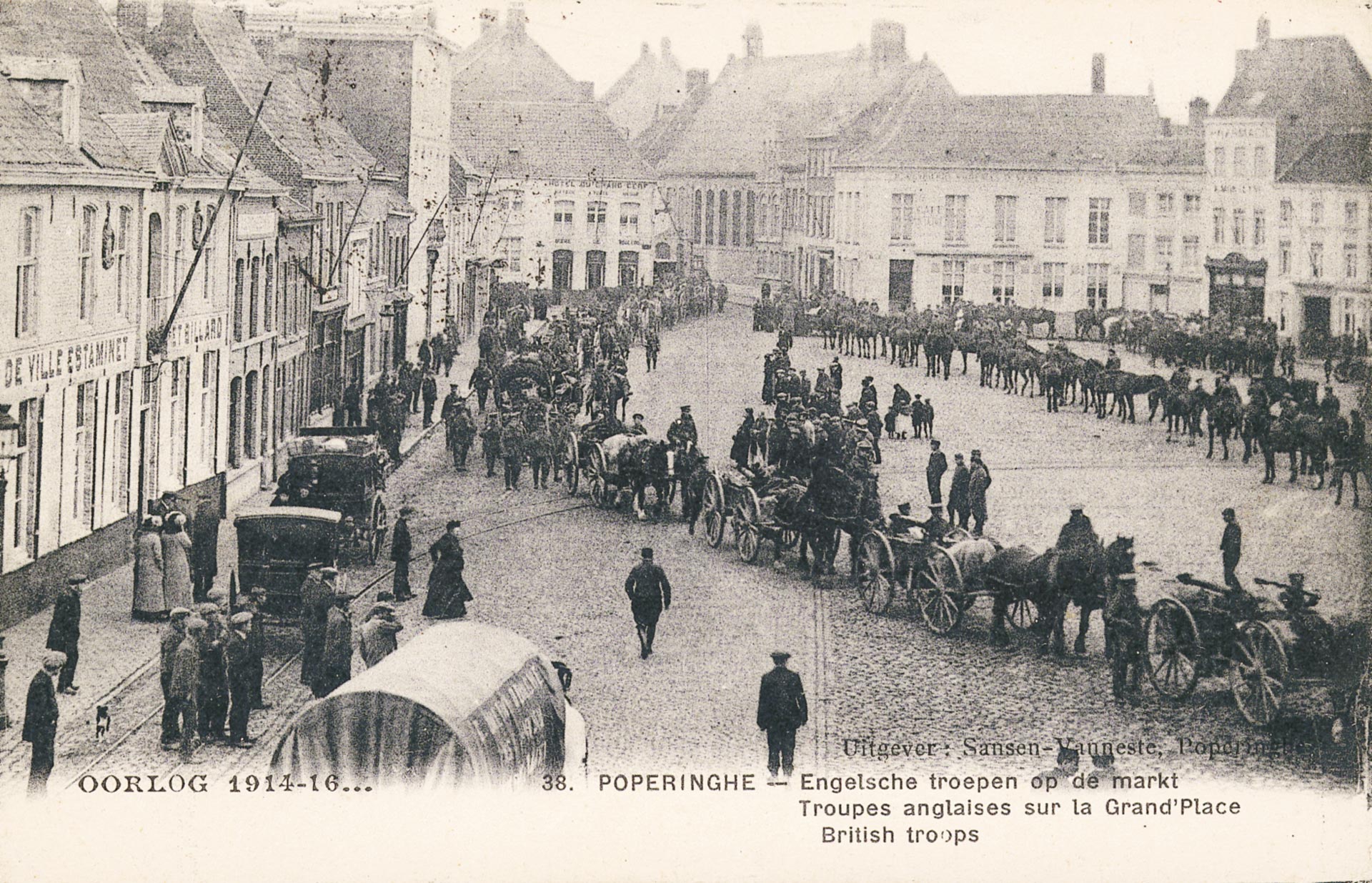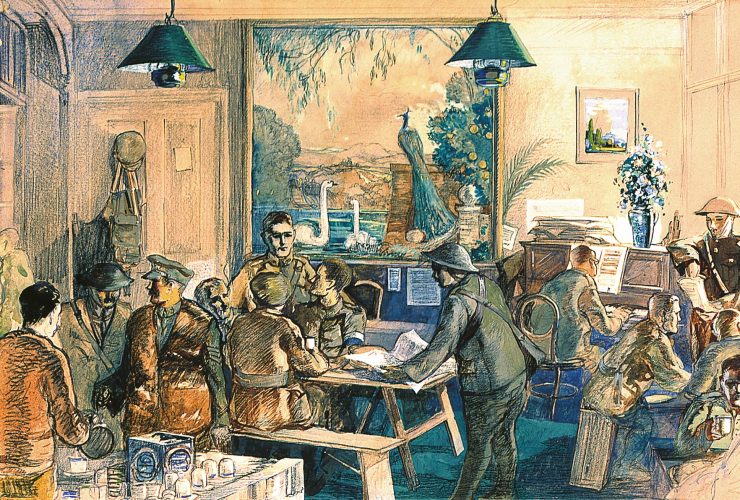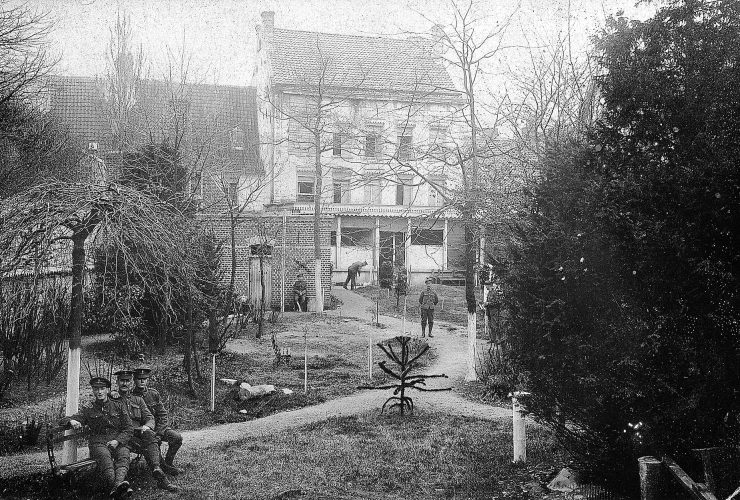Talbot House existed to support the men of the British Expeditionary Force (BEF) in 1915 and subsequently, the British Second Army. There was fighting in this sector almost constantly over the course of the war.
First Ypres: 1914
Following the German defeat on the River Marne (just north of Paris) in September 1914 and the subsequent battles on the River Aisne later that month, the German 6th Army tried to outflank the French Army and the BEF by attempting to seize a channel port. This became known as “The Race to the Sea”. During this period the BEF redeployed from the Aisne, north to Flanders, in order to protect the lines of communication back to the UK.
From September 26 to October 20, the Germans were forestalled in a series of actions:
- Amiens was held by the French 10th Army at the First Artois battle
- Lens taken by German forces
- Arras was held by the French Cavalry Corps
- Antwerp taken by German forces
- German forces take Ostend and Bruges.
By this stage, the Western Front was effectively solidified and the trenches were being dug. The German 6th Army was in the area Armentieres-Bethune and their new 4th Army was assembling in Flanders.
Ironically, given everything that happened subsequently, the German Cavalry actually entered Ypres on October 8, but left later that week.
On October 20, the German 4th Army (Duke of Wurrtemburg) launched its Langemarck (Ypres) offensive. Over four days, this offensive was held by the BEF, under Sir John French. Counter attacks by the French 8th Army (General D’Urbal) were unsuccessful.
On October 24, the German 6th Army (Prince Rupprecht) attacked La Bassee, but was held by French and British forces over five days.
On October 29, the German 6th Army renewed its offensive against Gheluvelt and Messines. The BEF and the French 8th Army defend solidly for seven days. Although the Germans took Messines and Wytschaete, the offensive failed, at a massive cost to both sides.
On November 4, both German armies attacked again over eight days, with only small gains.
The final German offensive (Nonne Boschen) was launched by 6th Army on November 11 against British and French forces, but it had no success.
The next day, the Germans ended the Ypres offensive and moved to defensive lines, sending six Corps east to meet the Russian offensive at Warsaw. Ypres had been saved, but the BEF had been decimated in the process.
Second Ypres: 1915
In the subsequent six months, the French mounted three unsuccessful offensives in the Champage region and, in March, the British mounted an unsuccessful offensive to retake the Aubers Ridge: the Battle of Neuve Chapelle.
On May 2 1915, the German armies in the east launched a massive offensive in Poland: the Gorlice-Tarnow offensive. In advance of that, German forces launched a series of diversionary actions in order to confuse allied intelligence. On April 22, the German 4th Army attacked British and French forces in the Ypres salient. The British lines held, but the French withdrew: a subsequent French counter at St.Julien was unsuccessful.
By May 1, the final British and French withdrawals were complete, following an attack by German forces on “Hill 60”. British casualties at 2nd Ypres were 30,000. This battle saw the first use of poison gas by the German Army.
Third Ypres: 1917
In the intervening period, the German primary focus for 1915 had been in the East. Subsequently, Germany attacked at Verdun in February 2016 in what turned into a zone of carnage over eleven months. The British launched the Somme offensive in July 2016, sustaining very heavy casualties over a four month period.
In April 1917, the Allied offensive (2nd Aisne) was launched, under General Nivelle. The British element (the Arras offensive) was successful initially, the British left (3rd Army: General Allenby) took the Vimy Ridge, but the right (5th Army: General Gough) was unsuccessful subsequently at Bullecourt. German resistance stiffened and the chance of a breakthrough was lost. The French element was a failure, with 90,000 dead. The political consequences were significant: Nivelle was replaced by Petain and the French armies mutinied: they would remain on the defensive for the next year.
In this context and with British merchant shipping under very heavy pressure from the new German policy of unrestricted submarine warfare, Britain planned an offensive to take the ports of Ostend and Bruges which were being used as U Boat bases. As a first step, the British 2nd Army (General Plumer) took the Messines Ridge on June 7, following the detonation of nineteen very large mines at three in the morning. This gives the British high ground in the southern part of the Ypres salient.
Critically, Britain delayed the launch of the 3rd Ypres offensive for nearly two months, with the attack now led by 5th Army (General Gough). Attacking at Pilckem Ridge on July 31 and then subsequently at Gheluvelt and Langemarck, the offensive was brought to a close on August 22, with little gain. Critically, torrential rain had started on the very first evening, which turned the battlefield to mud.
The British offensive was restarted on September 20 under 2nd Army (General Plumer). Using new “bite and hold” tactics of limited objectives, 2nd Army succeeded at Menin Road (September 20), Polygon Wood (September 26) and Broodseinde (October 4). However, German resistance was stiffening. Against the advice of his generals, Field Marshal Haig ordered the continuance of the offensive, with poor results (Poelcapelle, October 9) and then failure (Passchendaele Ridge, October 17). A further attempt at the Passchendaele ridge failed (October 26). With much of 2nd Army transferred to Italy after the defeat at Caporetto on October 24, the Canadian Corps finally took Passchendaele Ridge on November 6.
Passchendaele has now become a byword for military and moral futility. The ridge was the objective for the very first day. British forces did not get anywhere near Ostend.
1918: The German “Georgette” Offensive
With Russia now out of the war and the USA now in, Germany moved most of its eastern forces to the west, gambling that an expanded army in the west could defeat the British and French armies before the US armies could be deployed in significant numbers.
On March 21, Germany launched its offensive (codenamed “Michael”) on the Somme, followed by “Mars” at Arras (March 28), “Valkyrie” south of Arras (April 6) and “Georgette” against Ypres (April 9). The offensives caused significant allied losses (particularly British 5th Army on the Somme) but did not achieve their objectives.
At Ypres, “Georgette” aimed to destroy the British 1st Army on the River Lys. Aimed at Hazebrouck, it would then take out the Ypres salient. Initially, 1st Army suffered from the collapse of the Portuguese Corps, losing Armentieres, but held on at Givenchy. At Ypres, against 2nd Army, the Germans took Messines. With Haig’s declaration that “Our backs are against the wall”, the Passchendaele Ridge was lost, but otherwise – with very heavy reinforcements – the lines at Ypres were held. On April 16, German forces took Meteren and Wytschaete, but by April 20, the German Ypres offensive was nearly over. Germany took Mt Kemmel on April 25 and the offensive ceased on April 30. The Georgette offensive cost Britain 82,000 casualties.
1918: The Last Moves
The Allied counteroffensive – “The 100 Days” – started on August 8, at Amiens. Successful from the outset, with French and US forces both now fully engaged, this was the beginning of the end.
In Flanders, the Allied offensive started on September 28, led, symbolically, by King Albert of Belgium. With British, Belgian and French forces facing the German 4th Army (General Von Arnim), the armies took Wytschaete on the first day, the offensive ended on October 2.
The offensive restarted on October 14 and British forces were over the River Lys two days later. Roubaix and Tourcoing were taken on the 18th. However, an attempted crossing of the River Schelde failed on the 25th. A second attempt on the Schelde was scheduled for November 11, which –of course – became the day of the armistice.



